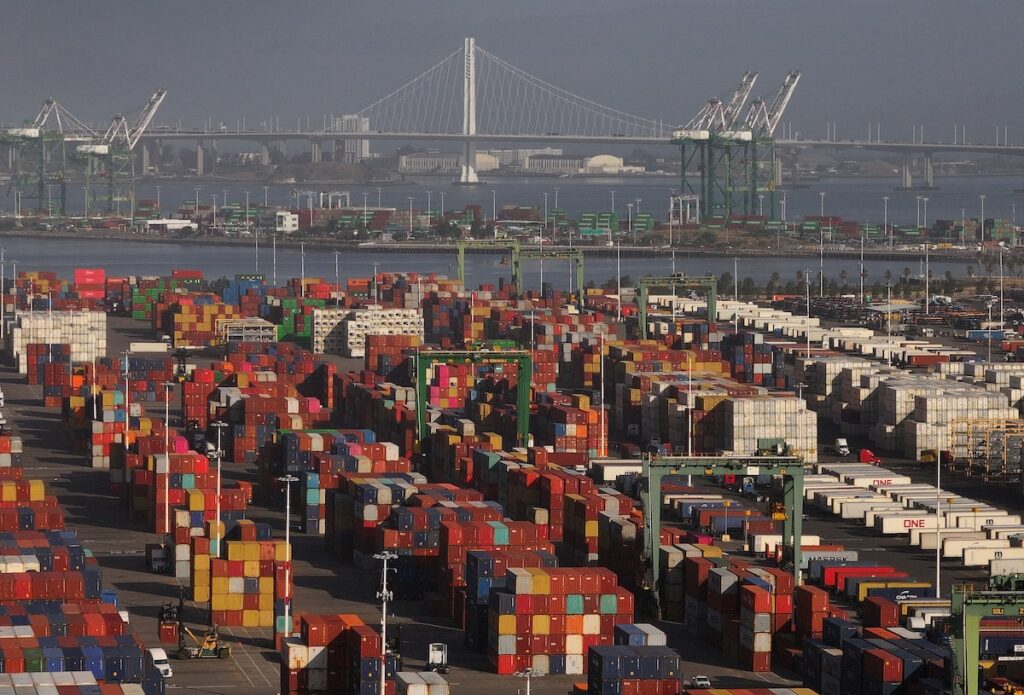Mark Levinson is a Washington historian and economist whose books include “The Box: How the Shipping Container Made the World Smaller” and “Outside the Box: How Globalization Changed from Moving Stuff to Spreading Ideas.”
Iran's seizure of an Israeli-linked container ship near the Strait of Hormuz on April 13 is just the latest storm to shake the global economy. Houthi attacks on shipping in the Red Sea, a drought-induced decline in the number of ships passing through the Panama Canal each day, and a resurgence of piracy in the Indian Ocean also highlight the fragility of the long-distance supply chains on which the global economy depends. But these supply chains are becoming less and less important. Trade in manufactured goods will grow slower than the global economy over the next few years, and consumers will feel the effects.
One reason for the trade slowdown is demographic. Populations are ageing rapidly in almost every region except sub-Saharan Africa as birth rates fall below replacement levels. The formation of new households, the main buyers of durable consumer goods, is declining in almost all middle- and high-income countries. Simply put, older households are buying less; it has taken them years to accumulate possessions, and they are more likely to spend their money on vacations, restaurant meals, and health care than on dresses and dining room furniture, manufactured goods that are shipped across borders.
Technological change is also slowing trade in goods. Electric cars have thousands of fewer parts than similar internal combustion engine vehicles, so the global shift to electric cars is affecting exports of parts such as pistons and mufflers. Capital investment by manufacturers has been sluggish, in part because industrial machines can be kept up to date by downloading software rather than replacing hardware. Traditional light bulbs are being replaced by light-emitting diodes, which are much smaller and cheaper.
Add to that the uncomfortable fact that long supply chains are becoming less reliable and slower. Twenty years ago, nine out of 10 container ships would arrive at port on or near their scheduled time; these days, that percentage is closer to half. While events like the recent Baltimore bridge collapse are obviously responsible for delays, the main reason is the industry's obsession with building ever-larger ships, loading larger and larger amounts of cargo into container terminals in each port call. With more containers stowed in the holds and on deck, and more trucks and trains needed to get the boxes to and from port, it takes longer than it used to to get containers off the ships.
In the past, ships could speed up to make up for time lost in port. But that's no longer so easy. Shipping lines are slowing ships down to conserve fuel, and newer ships generally can't go as fast as older ones. If you fall behind schedule, you often can't make up for lost time. To complicate things further, it's becoming common for shipping lines to cancel voyages to get ships back on schedule. A shipper who was supposed to ship cargo from China to Vancouver on a particular day may belatedly discover that the next opportunity is three weeks away.
Decoder: Red Sea attacks send global shipping rates soaring
These shipping delays and uncertainties increase costs for manufacturers and retailers who ship goods by ocean. They are forced to hold cargo for longer periods before selling, incurring additional financing costs and increasing the risk that goods will not be on hand when needed. Many companies deal with the risk of shipping delays by storing large amounts of inventory in warehouses, a trend that began during the COVID-19 pandemic and has continued since. Others are seeking multiple sources of suppliers for key components and finished goods. Either way, controlling supply chain risks translates into higher prices on the shelves.
Most of our consumer goods come from China and Southeast Asia, but manufacturers relocated production there decades ago. This has reduced the cost of many items. Baby clothes, window blinds, and kitchen appliances are all cheaper in the United States than they were at the beginning of this century. But a shortage of young people has made wages higher in many places that once attracted foreign companies with low wages, and manufacturing in many Asian countries is no longer cheap. Unlike in the early 21st century, lower import prices no longer help central banks control inflation with little pain for their citizens. Rising trade barriers and import/export restrictions due to geopolitical tensions are also driving up costs.
This is not the end of globalization. Rather, globalization is taking unfamiliar forms. Container ships laden with thousands of colorful metal boxes, mostly loaded with goods mass-produced in factories in low-wage countries with materials from other low-wage countries, are slowly becoming less important to the world economy. Globalization is increasingly concerned with the exchange of services, mostly in the form of numbers. Banks underwrite loans in one country, approve documents in another, and collect payments in a third. British book publishers call copy editors in Pakistan, movies that stream in Canada can be made anywhere, and lines are translated into multiple languages by artificial intelligence. In the business sector, the bulk of investment is directed toward research, software, and other non-physical expenditures, but it can be done wherever expertise is available, and intangible products move across borders with the click of a mouse.
These kinds of transactions are impossible to measure precisely: When an engineering firm in Toronto sends technical drawings to its branch in Paris, no money changes hands and officially no international trade occurs. But as globalization of manufacturing becomes less important in the world economy, the movement of non-physical products across borders becomes more important than ever. Under the radar, as companies seek talent around the world, globalization is moving away from things and increasingly toward the exchange of things that can't be seen or touched.



